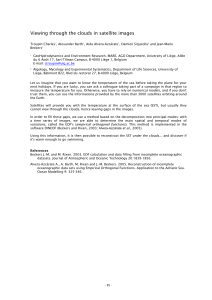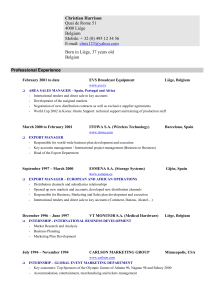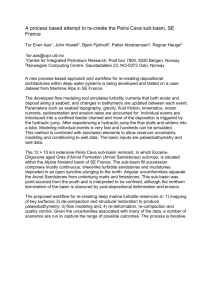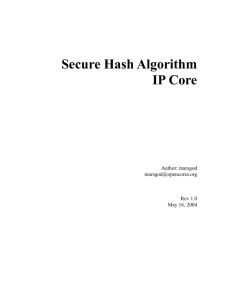Geophysical Research Abstracts Vol. 15, EGU2013-5021, 2013 EGU General Assembly 2013
advertisement
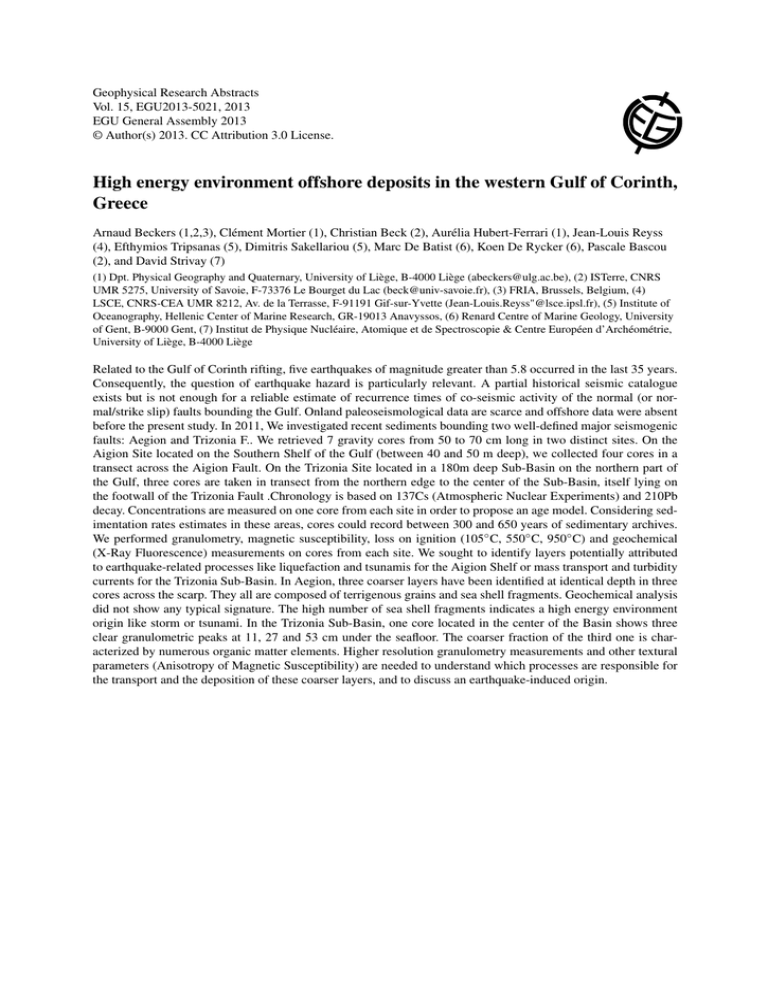
Geophysical Research Abstracts Vol. 15, EGU2013-5021, 2013 EGU General Assembly 2013 © Author(s) 2013. CC Attribution 3.0 License. High energy environment offshore deposits in the western Gulf of Corinth, Greece Arnaud Beckers (1,2,3), Clément Mortier (1), Christian Beck (2), Aurélia Hubert-Ferrari (1), Jean-Louis Reyss (4), Efthymios Tripsanas (5), Dimitris Sakellariou (5), Marc De Batist (6), Koen De Rycker (6), Pascale Bascou (2), and David Strivay (7) (1) Dpt. Physical Geography and Quaternary, University of Liège, B-4000 Liège (abeckers@ulg.ac.be), (2) ISTerre, CNRS UMR 5275, University of Savoie, F-73376 Le Bourget du Lac (beck@univ-savoie.fr), (3) FRIA, Brussels, Belgium, (4) LSCE, CNRS-CEA UMR 8212, Av. de la Terrasse, F-91191 Gif-sur-Yvette (Jean-Louis.Reyss"@lsce.ipsl.fr), (5) Institute of Oceanography, Hellenic Center of Marine Research, GR-19013 Anavyssos, (6) Renard Centre of Marine Geology, University of Gent, B-9000 Gent, (7) Institut de Physique Nucléaire, Atomique et de Spectroscopie & Centre Européen d’Archéométrie, University of Liège, B-4000 Liège Related to the Gulf of Corinth rifting, five earthquakes of magnitude greater than 5.8 occurred in the last 35 years. Consequently, the question of earthquake hazard is particularly relevant. A partial historical seismic catalogue exists but is not enough for a reliable estimate of recurrence times of co-seismic activity of the normal (or normal/strike slip) faults bounding the Gulf. Onland paleoseismological data are scarce and offshore data were absent before the present study. In 2011, We investigated recent sediments bounding two well-defined major seismogenic faults: Aegion and Trizonia F.. We retrieved 7 gravity cores from 50 to 70 cm long in two distinct sites. On the Aigion Site located on the Southern Shelf of the Gulf (between 40 and 50 m deep), we collected four cores in a transect across the Aigion Fault. On the Trizonia Site located in a 180m deep Sub-Basin on the northern part of the Gulf, three cores are taken in transect from the northern edge to the center of the Sub-Basin, itself lying on the footwall of the Trizonia Fault .Chronology is based on 137Cs (Atmospheric Nuclear Experiments) and 210Pb decay. Concentrations are measured on one core from each site in order to propose an age model. Considering sedimentation rates estimates in these areas, cores could record between 300 and 650 years of sedimentary archives. We performed granulometry, magnetic susceptibility, loss on ignition (105◦ C, 550◦ C, 950◦ C) and geochemical (X-Ray Fluorescence) measurements on cores from each site. We sought to identify layers potentially attributed to earthquake-related processes like liquefaction and tsunamis for the Aigion Shelf or mass transport and turbidity currents for the Trizonia Sub-Basin. In Aegion, three coarser layers have been identified at identical depth in three cores across the scarp. They all are composed of terrigenous grains and sea shell fragments. Geochemical analysis did not show any typical signature. The high number of sea shell fragments indicates a high energy environment origin like storm or tsunami. In the Trizonia Sub-Basin, one core located in the center of the Basin shows three clear granulometric peaks at 11, 27 and 53 cm under the seafloor. The coarser fraction of the third one is characterized by numerous organic matter elements. Higher resolution granulometry measurements and other textural parameters (Anisotropy of Magnetic Susceptibility) are needed to understand which processes are responsible for the transport and the deposition of these coarser layers, and to discuss an earthquake-induced origin.

